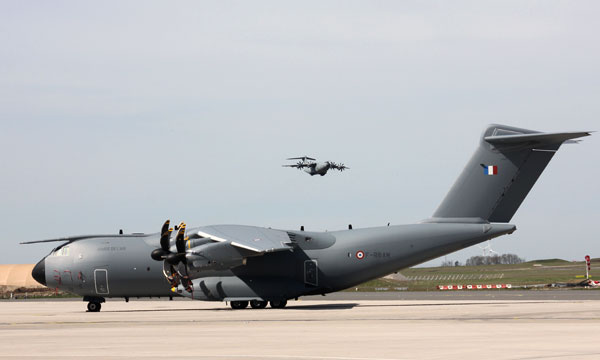Changes to come for the maintenance of French Air Force's A400M fleet |
| Helen Chachaty |
|
|
20 SEP 2018 | 764 words
|
 |
© Helen Chachaty/Le Journal de l'Aviation - All Rights Reserved |
|
|
|
"When it comes to maintenance in operational condition for the A400M, we need to recognise that things are moving into place relatively well", one pilot explained to us recently. The transport plane was even presented as "pretty good" in this area. While the objective of the aviation MOC reform, which was launched in December 2017 by the French Minister of the Armed Forces Florence Parly, is to move towards "vertical" contracts with a single type of labour, the A440M could almost set an example.
"We've been committed to the principle of a single contact from the very beginning. The contracts are signed with Airbus for the whole cell, with EPI for the engines and it stops there for the industrial part". Other contracts have of course been signed to organise the scheduled maintenance, but still with this vertical organisation in mind. Other agreements have also been signed with partner countries, the United Kingdom and Spain, to provide a common spare parts stock, technical support and maintenance engineering services, to share resources and rationalise costs.
These current MOC contracts could develop gradually over the next few years. The A400M programme is not yet covered by an overall fly by the hour contract, an option which our source thinks is "ideal". However, he does play down their comments by raising the need to be able to count on an industrial partner who has "perfect knowledge of their machine", and a "well-defined" contract. There would be no advantage for the air force in signing this type of contract, as the programme is still in development for the tactical capacities: "The industrial partner can commit to it, but they'd need to agree to take risks and so provide a very expensive contract". At the moment, the goal is more to have availability contracts, which would enable parts and technical assistance to be provided as quickly as possible.
The evolution will be spread "over several years" and "accompany the maturity of the aircraft", with a gradual change from a parts availability service to a fly by the hour service. "Shifts in delivery don't necessarily help us", we were told at the air force chief of staff office. While the first French planes are no longer under warranty and so require "support from robust contracts", the approach is different for the planes delivered more recently.
"Our objective is to engage the aircraft, in the long-term and away from mainland France. With this in mind, we need to guard a skills base and we'll never be able to outsource everything". Engaged in the Sahel-Saharan strip, in the Middle East and also in territories that are hit by natural disasters - the Caribbean after Hurricane Irma in September 2017, Lombok Island in Indonesia this summer - the aircraft must be able to be put back into service "whatever the circumstances". "We need to think about this need to be able to engage in low-security environments, which means that we need to be able to service the planes ourselves and have qualified mechanics", we were told. The opposite approach is taken in the United Kingdom for example, which has gone much further down the outsourcing path, but which seems to be wondering about the relevance of its model.
In a recent meeting with journalists specialized in aeronautics, the French Minister of the Armed Forces Florence Parly indicated that her positive perception of the programme was reflected in particular in the increase in fleet availability. If the average rate was very low at the start of the year, around 3.2 aircraft, it should rise to 8 aircraft by the end of 2018. "There's still a lot of work to be done, but what's important is that the dynamic is now underway", she declared.
The upward trend in the availability rate was confirmed to us by the operational side, with 7 aircraft out of 8, or even 8 aircraft out of 9 this summer. The Touraine squadron has a very busy flying schedule. Le Journal de l'Aviation was told that certain pilots had already exceeding 400 flying hours since the start of the year and that the 1 000-hour marker can easily be reached in two years. The number of pilots who pass this symbolic figure should rise quickly over the coming months. They would then join the "1 000 Club", which records the pilots, mechanics and loadmasters who log over 1000 flying hours on the A400M. The entire French fleet has also exceeded the symbolic threshold of 10 000 flying hours since the first A400M aircraft was brought into service in August 2013. |
|
| |
| |
They made this section possible |
|
|
|
|
|
|
|
|
|
|
|
|
|
|
|
|
Top stories |
|
|
|
|
|
Top stories
|